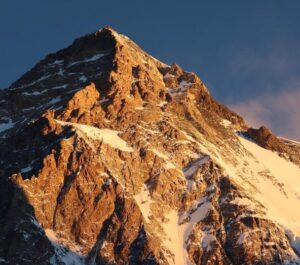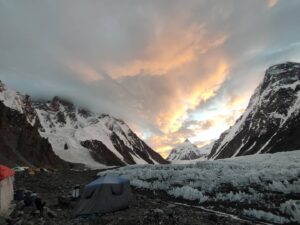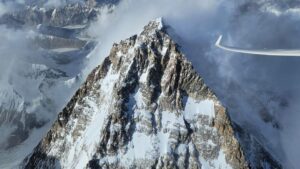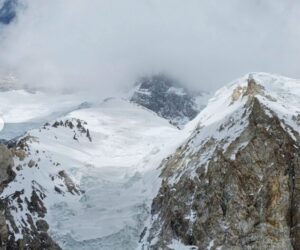BY VALENTYN SYPAVIN
After the successful ascent of K2 in the summer of 2021, my team went home. All clients reached the summit, including the first Russian woman, Olga Koroleva, and the first Ukrainian woman, Irina Galay. I am very happy. However, I am haunted by the thoughts of what happened to the three brave men who attempted to summit K2 last winter but who did not return. These were Muhammad Ali Sadpara (Pakistan), John Snorri (Iceland), and Juan Pablo (JP) Mohr (Chile).
For several months, this question has haunted many people: What happened? Sajid Ali Sadpara, Ali Sadpara’s son, and Elia Saikaly launched an expedition to find out. I was there too, as an ordinary guide and climber who was leading a commercial expedition. I want to say that I grieve with all the relatives and friends of the victims and offer my sincere condolences. Here, I’m just presenting exactly what I saw and some of my assumptions.
The main questions, in my opinion, are: Did the three climbers reach the summit of K2 before they died? If so, did they all do it? And lastly, why did they die?
These questions may be answered in future by checking the cameras of the victims. But I was the first to find one body [JP Mohr] and saw two more bodies on the way to the summit 10 days ago. Since not much on these circumstances has appeared since then, I would like to offer my firsthand findings.
I first reached Camp 4 on July 26 at 11:30 am. Of course, I started photographing the Bottleneck. At this time, a team of Sherpas were working on the route below the Serac. If I am not mistaken, these were three Sherpas from our Alpomania-Pioneer team and four Sherpas from the Madison team.
I immediately noticed that two large black points lay on the route at different heights, much higher than the Bottleneck, and dark lines resembling ropes went up and down from them. After my clients reached Camp 4, I gave them tea, took 100m of rope, and went higher in order to facilitate the work on the night of the summit push.
At this time, Elia [Saikaly] attacked our sirdar, Lakpa Sherpa, saying that this was not a race and why I was I going there. I still do not understand why Elia did this, and other witnesses of the event were in shock. But after about an hour and twenty minutes, I reached the beginning of the fixed ropes and saw a yellow piece of fabric in the snow to the far left. This fabric was not visible from C4. I got curious and came closer to the fabric.

Sypavin’s watch at the time that he found the body of JP Mohr.
JP Mohr
I felt that the small piece of fabric sticking out of the snow could be attached to something bigger, even though no human traces, like parts of crampons or boots, were visible.
I immediately took a photo and video of the position of this piece of fabric relative to the Bottleneck and C4. I had an ice ax and started carefully digging. Immediately, I saw that it was a North Face yellow-and-black down suit or jacket.
I felt cold inside. Then I took out a GoPro and began to film my findings. At first, I saw the harness — which at first I took for a backpack strap — and then the top of the boots. They were the new Scarpa 8000 model with a straight zipper.
I then got to the bottom of the Petzl crampons. These were blunt. I did not recognize the model of these crampons. After realizing that the suit and the boots were new and that this was a body, I didn’t dig further.
Since a special expedition was working on the mountain to find these bodies, I decided that it was necessary to convey this information to them as soon as possible. It was then up to them to continue. I did not excavate the face of the climber or open any areas of the body. At the time, I did not know who it was because I did not know who was wearing that suit and boots.
The deceased was lying with his head facing west and his feet facing east, legs in the fetal position. The suit and boots were intact with no signs of damage from a fall or anything else.
There were no obvious unnatural body positions caused by, for example, limb fractures. There were no ropes and no backpack on his back. The body was far from the Bottleneck. If one goes down from the Serac without oxygen, it would take at least one hour to reach this place. Most likely, the climber froze and died from exhaustion.
After taking photos, I left my rope a little higher and went to C4 to tell about the body. Elia was kind to me and asked me to show the location of the body for his drone, but we did not manage to start it. Then they (Elia and Sajid) made a video where I tell about the find and show the photos on my phone. Meanwhile, the Sherpas descended to C4 without reaching the higher black dots that I saw earlier.
The summit push took place on the night of July 27, 2021. The Sherpas, clients, high altitude porters, and several Pakistani climbers were on their way. Three Sherpas (Sanu, Pemba Rita, and possibly Chiring) from the Alpomania-Pioneer team worked higher on the route.
After them, I was the first to climb on fixed ropes, followed by my clients and Sherpas. After the traverse under the Serac, the ascent began. At the end of a steep ice wall, we encountered a body. I immediately realized that this was a deceased climber. I had seen many of them on Everest. It was dark and I could not see much. I examined the body more carefully during the descent, when it was light. Here’s what I can say.

Sherpas fix ropes toward the bodies of Ali Sadpara, below, and John Snorri, above.
Ali Sadpara
The deceased was lying on his back, upside down. There were several fixed ropes around. The deceased was in a Kailas suit. The suit had faded in the sun and was intact, undamaged, untorn. He was wearing Millet boots and Petzl crampons. The crampons were very blunt. The arms were spread out to the sides. He was wearing a hood and a backpack. In other words, Ali was lying on his backpack. His left hand was ungloved. An old green rope was wrapped around the left crampon. He was wearing a harness. A figure 8 descender was attached to the rope.
It is absolutely certain that Ali was descending. The body lay on a flat surface. Since the rope was fixed to a nearby anchor, I assume that there was no fall from a height. It is possible that Ali was simply descending facing toward the mountain on the fixed ropes (in the darkness?). He may have caught his foot in the rope and fell on his back. He might have been completely exhausted and not able to get up anymore.
About 100m above, a third body hung on the fixed ropes.
John Snorri

Snorri’s location: 1. Red fixed rope; 2. Snorri’s carabiner (and body); 3. Broken snow anchor with the snagged rope; 4. Fixed rope heading down
There is a clear picture of what happened. The body hung in a fetal position, with his face to the west and his back to the east. His crampons Grivel G21+ were very blunt. His face looked down. He had no dark glasses, and the left hand did not have a glove.
Many people say that Snorri never used a descender because he went down on a carabiner, Sherpa style, with the rope wound around his hand. I can confirm that he was descending. The climber had a long lifeline that was clipped to the fixed rope with a carabiner.
The fixed rope had a lot of slack, and it played a cruel joke. During the descent, Snorri reached a snow anchor that was broken in half and caught the fixed rope. It formed a loop of fixed rope, in which Snorri found himself caught. He might not have seen it in the dark or because of fatigue. If one descends facing away from the mountain, one might not see it.
In any case, he found himself caught on a tight loop of the fixed rope. He would have had to climb to the snow anchor in order to release the snagged rope. This would be about three metres up the ice slope, on the front teeth of his crampons, without a jumar.
Alternatively, he could clip the carabiner of his lifeline from the snagged fixed rope to the proper fixed rope. This was also very difficult, as the rope was already very tight. In any case, Snorri did not have the strength to get out of this situation. I think he was just exhausted. Was it dark and cold? What was the weather? These are no longer questions for me.

Valentyn Sypavin at the site of his discovery of JP Mohr’s body.
Summary
Snorri and Sadpara were definitely descending. There were no falls and no mystery. K2 is a difficult, high mountain in winter. They started the summit push from C3 (7,330m!). I think that if there had been a tent in C4, then JP would have had chances to survive. JP is said to have moved quickly on the mountain. Most likely, he had already descended below the Bottleneck, was waiting for the others, and froze to death.
Yet another question concerns the crevasse above C3. I followed the 2021 winter ascent of K2 and read that some climbers complained that the Sherpa climbers did not warn them about a large crevasse. This crack allegedly blocked the path on the summit push and could not be bypassed.
It is very strange that I have not seen a single photo of this crevasse. It is also strange that 10 Sherpas were able to get around it. And the three deceased climbers were able to overcome it too.
In summer, there are no crevasses at all above C3, despite the fact that for six months the bodies of the deceased climbers, especially JP Mohr, lay practically on the surface. This suggests that new snow had not filled and hidden the crevasse.
This is everything that I wanted to report. Of course, further data from the photographs and video files from the cameras of the victims may further clarify what happened that day. I don’t want to speculate.
Translated by Ganna Rozhnova
EDITOR’S NOTE: While we have not posted close-up photos of the bodies, their position on the mountain may be relevant to understanding what happened. So we have included those distant shots only.






